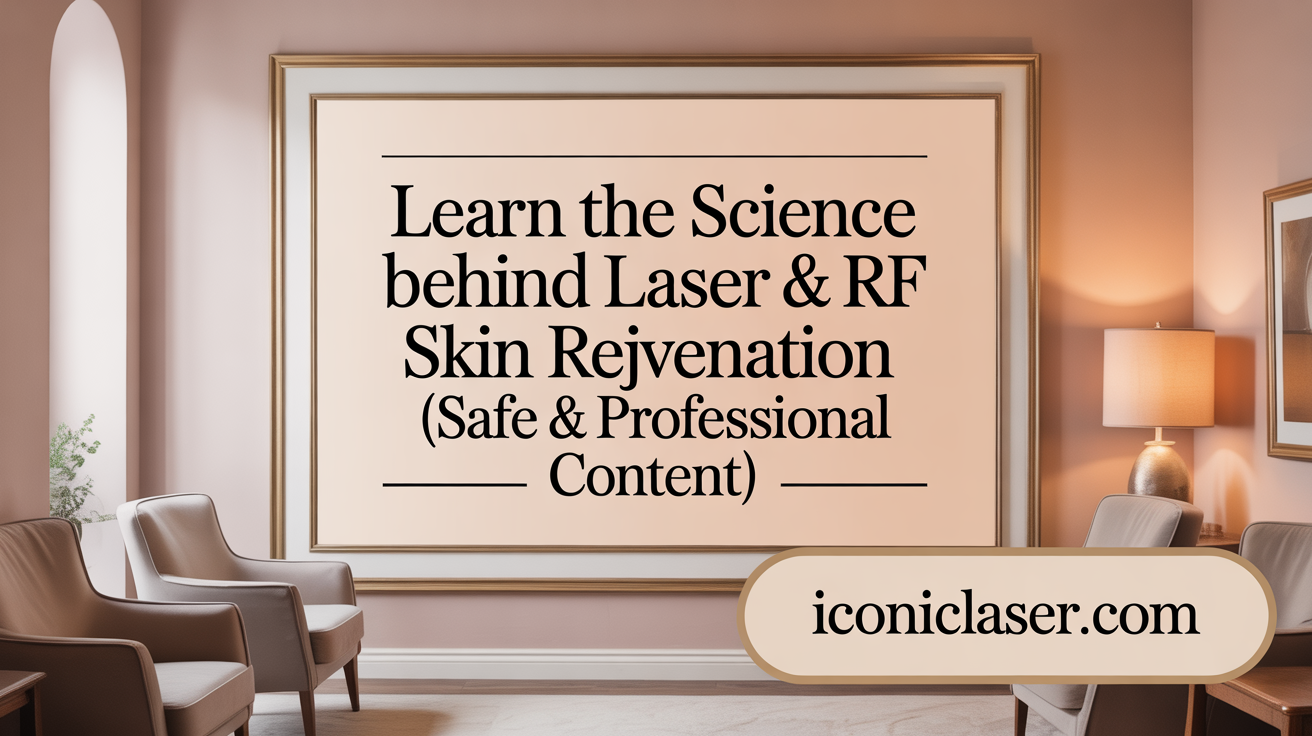Discover the Science Behind Your Glow
In the quest for healthier, more youthful skin, advanced laser and radiofrequency (RF) treatments have emerged as leading solutions. These cutting-edge therapies offer non-invasive ways to rejuvenate skin, reduce signs of aging, and restore confidence through customized care. This article delves into how these technologies work, their benefits, different treatment options, and what to expect throughout your skin transformation journey.
Understanding Laser and Radiofrequency Skin Rejuvenation: How They Work

What is laser and radiofrequency (RF) skin rejuvenation, and how do these treatments work?
Laser and RF skin rejuvenation are popular non-invasive procedures designed to enhance the skin’s appearance by tackling signs of aging, improving texture, and increasing firmness. These treatments often appeal to individuals seeking alternatives to surgical options with minimal downtime.
Laser treatments utilize focused light energy to target specific issues within the skin. Depending on the type, they can be ablative, removing outer damaged layers, or non-ablative, heating the underlying skin without damaging the surface. Ablative lasers, like CO2 lasers, effectively improve scars, wrinkles, and sun damage by stimulating collagen and elastin production during the skin's healing process.
RF treatments use electromagnetic waves to generate heat deep within the skin layers. This controlled heating tightens the existing collagen and encourages the body to produce new collagen and elastin fibers, resulting in firmer, more youthful skin. RF devices can be used alone or combined with other technologies such as microneedling to enhance results.
Advanced RF treatments, like Virtue RF or Morpheus8, incorporate tiny needles (microneedles) that create micro-injuries, allowing RF energy to reach deeper tissue layers. This combination stimulates extensive collagen synthesis, improving skin elasticity and reducing fine lines.
The common mechanism behind these therapies is the heating of targeted tissues, which prompts the body’s natural healing process to generate new collagen and elastin. Over weeks and months, these changes lead to smoother, tighter, and more resilient skin, making laser and RF treatments effective solutions for aging skin concerns.
How do these modalities differ?
| Aspect | Laser Resurfacing | RF Skin Tightening | Combined RF & Microneedling |
|---|---|---|---|
| Principle | Focused light heats or removes skin layers | Electromagnetic waves heat deeper tissues | Microneedles create microchannels + RF energy |
| Treatment depth | Surface to mid-dermis | Deep dermis | Deep dermis |
| Typical results | Immediate with long-term benefits | Gradual improvement | Gradual with quicker recovery |
| Downtime | 1-2 weeks | Minimal (1-2 days redness) | Minimal (a few days redness) |
| Best for | Wrinkles, scars, sun damage | Skin tightening, early aging signs | Skin tightening, scars, pore size |
What is the role of microneedling combined with RF?
Microneedling with RF, such as Virtue RF or Morpheus8, enhances collagen production by creating micro-injuries that stimulate the skin's natural repair mechanisms. The embedded RF energy heats the deeper tissues via these tiny channels, promoting further collagen and elastin fiber remodeling.
This combination offers a versatile approach to address various skin concerns across the face, neck, and body. It provides substantial improvements in skin texture, firmness, and elasticity, and can help diminish the appearance of scars and enlarged pores.
Overall, both laser and RF treatments leverage the body's healing response—heating tissues to stimulate new collagen. Choosing the right method depends on specific skin issues, skin type, and desired outcomes. Consulting with a qualified skin professional ensures the safest and most effective customized treatment plan.
Benefits, Effectiveness, and Safety of Laser and RF Skin Treatments

What are the benefits and effectiveness of laser and RF skin treatments?
Laser and radiofrequency (RF) skin procedures have become popular choices for individuals seeking non-invasive skin rejuvenation. These treatments offer numerous advantages, prominently including the reduction of wrinkles, fine lines, and skin sagging. They stimulate collagen and elastin production in the deeper skin layers, which results in improved skin texture, increased firmness, and a more youthful appearance.
Most patients notice visible improvements within a week, with continued enhancement over several weeks. RF treatments, such as monopolar RF and RF microneedling, are particularly effective at skin tightening because they heat the deep dermal layers to promote collagen remodeling. Laser options, like skin resurfacing, remove or heat the outer skin layers to reveal fresh skin underneath, addressing issues like sun damage, scars, and uneven pigmentation.
These procedures are renowned for their quick execution times—often less than an hour—and their minimally invasive nature means minimal discomfort and downtime. As a result, they are suitable for a wide array of skin concerns and skin types, producing natural-looking, gradual results that often lead to high patient satisfaction.
What are the safety considerations and professional expertise required for laser and RF skin treatments?
Ensuring safety during laser and RF skin treatments is crucial for optimal results and to prevent complications. These procedures should always be performed by licensed, experienced professionals such as dermatologists, plastic surgeons, or certified aestheticians trained on the specific devices used.
Standards for safety, such as those set by ANSI Z136, mandate proper safety protocols, including the use of protective eyewear specific to the device’s wavelength and protective shields for patients. Professional expertise involves understanding device settings, patient assessment, and post-treatment care to reduce risks such as burns, redness, swelling, and pigmentation issues.
Proper pre-treatment instructions—such as avoiding sunburn and certain skincare products—and post-treatment guidance like sun avoidance are essential for safety. Facilities should maintain strict safety practices, including having a trained laser safety officer and adhering to all safety guidelines. When performed correctly, these treatments are safe, effective, and highly satisfying for patients seeking skin rejuvenation, with minimal risk of adverse effects.
Breakthrough Technologies: Exploring Morpheus8, Pixel RF, and Forma
What are some advanced laser and RF technologies used for skin rejuvenation, such as Morpheus8, Pixel, and Forma?
Modern skin rejuvenation has seen the emergence of sophisticated devices that combine radiofrequency (RF) energy with other modalities to enhance skin health and appearance.
Morpheus8 is a notable example, utilizing microneedling combined with RF energy. This dual approach stimulates collagen and elastin production deep within the skin layers, making it effective for improving skin firmness, texture, and reducing fine lines. It is particularly useful for targeting areas like the face and neck.
Forma, on the other hand, employs radiofrequency heating to gently warm the dermis. This process facilitates collagen remodeling, resulting in skin tightening without significant downtime. Forma is ideal for patients seeking a non-invasive method for early signs of aging.
Pixel RF offers a different approach by combining laser and radiofrequency technologies in a fractional format. It creates tiny micro-injuries on the skin surface, promoting healing and new cell growth. This treatment improves skin tone, reduces sun damage, scars, and diminishes the appearance of wrinkles, delivering visible results over several weeks.
In addition to these, monopolar and bipolar RF devices, such as the Legend Pro™, are frequently employed for skin tightening. They deliver controlled heat to contract existing collagen and stimulate the production of new collagen, resulting in a gradual lift and firming effect.
Laser and light-based therapies play a complementary role, targeting vascular issues, pigmentation, and uneven skin tone. Treatments like pulsed dye lasers, Nd:YAG, and IPL often work alongside RF methods for comprehensive skin rejuvenation.
These technologies are typically performed in outpatient clinics by licensed professionals. They offer effective, minimally invasive options that improve skin texture, support structural skin improvements, and often require minimal downtime, making them appealing for many seeking aesthetic enhancements.
Personalizing Your Treatment: Choosing the Right Procedure for Your Skin
How are laser and RF treatments customized to suit individual skin concerns?
Laser and RF treatments are tailored to each person during detailed consultations with experienced providers. These specialists assess the patient's skin type, concerns, and aesthetic goals before selecting appropriate devices and protocols. For example, fractional lasers or radiofrequency systems like Morpheus8 or Pixel RF can be adjusted in terms of energy levels, depth, and treatment settings. They can also combine multiple technologies to target specific issues such as wrinkles, scars, or skin laxity more effectively.
The treatment customization considers skin sensitivity, ethnicity, and severity of conditions to optimize outcomes while minimizing risks. The provider might choose more superficial settings for sensitive skin or darker tones, or deeper treatments for significant laxity or scarring. This approach of precise individualization ensures that each patient receives a safe, effective treatment plan tailored to their unique needs, leading to improved skin texture, tone, and overall appearance.
What factors should be considered when choosing the appropriate skin rejuvenation procedure?
When selecting a skin rejuvenation treatment, multiple factors play a role. The patient’s skin type—whether oily, dry, sensitive, or combination—significantly influences the choice of procedure. Specific concerns like fine lines, deep wrinkles, pigmentation, scars, or sagging will also guide recommendations.
Another crucial factor is the desired downtime. Treatments like laser resurfacing or deep chemical peels may require longer recovery periods, while options such as microneedling or RF treatments typically involve minimal downtime. Budget and comfort levels regarding potential risks are also important considerations.
Consulting with a qualified skincare professional helps in creating a personalized plan. They evaluate the skin’s condition and recommend procedures suited to the individual’s goals, lifestyle, and skin characteristics. This ensures safer treatment choices, better results, and increased satisfaction.
Comparing laser resurfacing with RF microneedling
Laser resurfacing and RF microneedling are both effective methods for skin rejuvenation but differ in approach and results. Laser resurfacing involves the use of concentrated light energy to remove or heat the outer skin layer, stimulating collagen production and smoothing surface imperfections. Ablative lasers provide more dramatic, immediate results but may require longer downtime.
RF microneedling, on the other hand, uses fine needles to create micro-injuries combined with radiofrequency energy. It primarily targets deeper layers to stimulate collagen and elastin production gradually, with minimal downtime. RF microneedling is suitable for improving skin texture, reducing scars, and tightening, especially for individuals seeking less invasive options.
Both treatments can be customized in terms of depth and intensity, but laser resurfacing often addresses more pronounced surface concerns, whereas RF microneedling focuses on overall skin quality and firmness.
Considerations for skin tone and downtime
When selecting skin rejuvenation options, skin tone and downtime are vital factors. Laser treatments, especially ablative ones, carry a higher risk of pigmentation issues in darker skin tones, requiring careful selection and settings adjustments. Non-ablative lasers and RF microneedling are safer choices for darker skin, offering effective results with less risk.
Downtime varies significantly across treatments. RF microneedling usually involves redness that subsides within a day or two, making it suitable for busy schedules. Laser resurfacing can involve a week or more of redness and peeling, requiring planning around social or professional commitments.
Ultimately, understanding personal skin tone and lifestyle needs helps determine the safest and most convenient options, ensuring consistent and satisfying skin rejuvenation results.
What to Expect: Results, Recovery, and Investment in Laser & RF Treatments

What should patients expect regarding results and recovery from laser and RF skin procedures?
Patients undergoing laser and radiofrequency (RF) skin treatments can anticipate gradual improvements over time. Collagen stimulation and skin renewal are ongoing processes, so most results become visible within several weeks to months post-treatment.
Laser procedures, especially ablative types, may involve noticeable redness, peeling, and swelling during the initial recovery phase, which can last about a week or more. Complete healing might take up to a month, but these treatments often deliver significant improvements in skin texture, tone, and firmness.
Non-ablative and fractional laser options typically involve shorter or minimal downtime, allowing patients to return to daily routines more quickly. RF treatments are generally well-tolerated, causing only mild redness or swelling that resolves within 24 hours. They can often be performed during a lunch break with no need for extended recovery.
Visible enhancements in skin appearance can be seen within a few weeks, with more noticeable results emerging over three to six months. Collagen continues to remodel during this period, further improving skin's elasticity and smoothness.
To maintain results, patients should adhere to post-treatment care instructions, including sun protection, gentle skincare routines, and sometimes follow-up sessions. Combining treatments and establishing good skincare habits can lead to longer-lasting and more satisfying outcomes.
What is the typical cost range for radiofrequency skin tightening treatments?
The expense of RF skin tightening varies widely based on the device used, treatment area, and geographic location. Typically, individual sessions cost between $582 and $5,878.
On average, patients spend around $755 to $1,230 per session, with premium options like Thermage averaging about $1,230. For instance, in some clinics like Beverly Hills Med Spa, the price might be approximately $900 per session.
Most treatment plans involve multiple sessions—often 3 to 5—to achieve optimal results. The total investment depends on the number of sessions and the specific areas being treated, such as face, neck, or body.
During a consultation, practitioners will provide a tailored estimate based on individual goals, skin condition, and budget. Patients should consider both the immediate costs and the potential for longer-lasting benefits when planning their aesthetic investments.
Embrace Your Skin's Potential with Tailored Laser & RF Care
Laser and radiofrequency skin rejuvenation treatments provide a powerful, science-backed avenue to restore your skin's natural vitality and youthfulness. By understanding how these technologies work and exploring advanced options like Morpheus8 and Pixel RF, you can select a personalized approach tailored perfectly to your unique skin concerns and goals. With professional expertise ensuring safety and effectiveness, minimal downtime, and visible, lasting results, these treatments offer a compelling option for anyone committed to revealing their best skin. Consult with a qualified specialist to embark on your skin transformation journey today.
References
- Radio Frequency (RF) Skin Tightening: Benefits & Dangers
- Pixel RF & Pixel Treatment | Laser Skin Resurfacing | Vancouver WA
- Redefine Your Skin's Radiance with Define by InMode
- Skin rejuvenation with Skinpen and Radiofrequency VIRTUE ...
- How laser and radiofrequency treatments rejuvenate your skin | ASPS
- RF Microneedling vs. Laser Resurfacing: Which Skin Treatment Is ...
- Refresh your skin with our CO2 Laser or RF Microneedling treatments!
- Matrix RF™ - Skin Rejuvenation - Advanced Dermatology
- Radiofrequency Skin Treatments Vs. Laser Therapy
